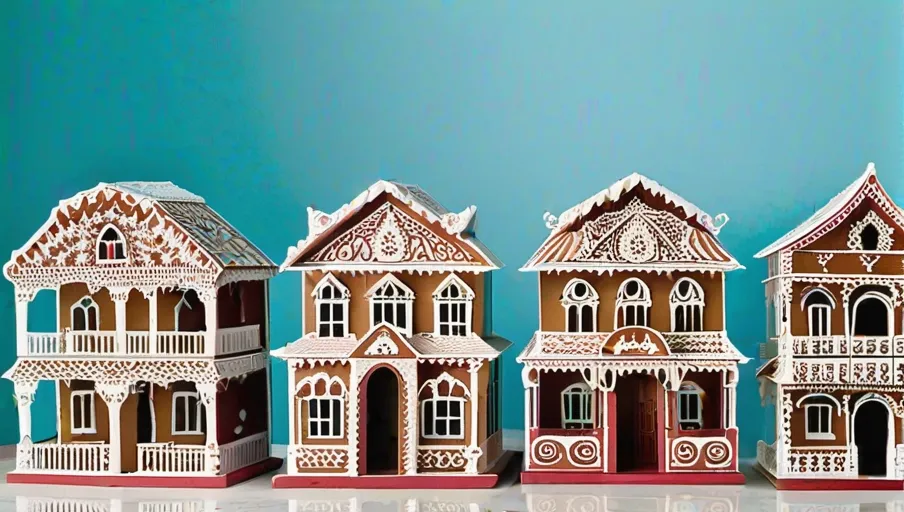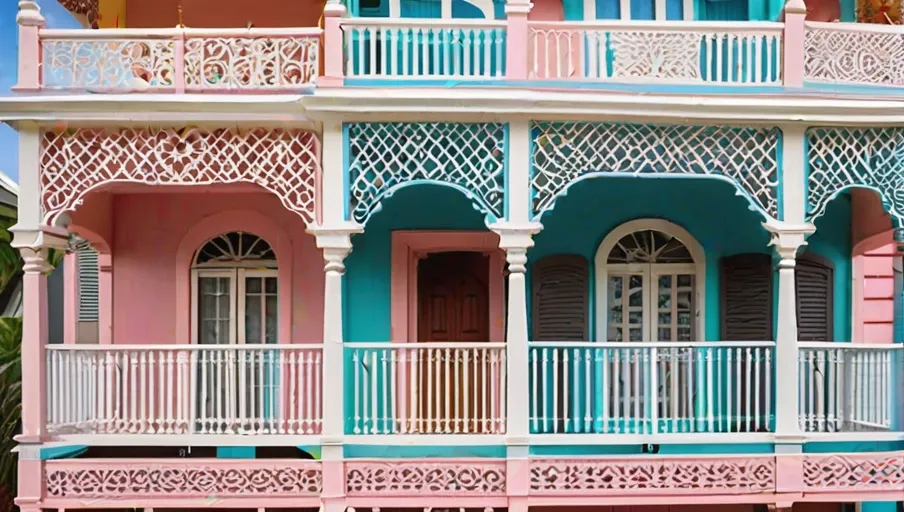
Discover the captivating architectural heritage of Haiti with a visit to the stunning gingerbread houses.
Originally built as residences for powerful Haitian families, these remarkable structures combine French-inspired Victorian Gothic grandeur with vibrant colors and decorative patterns.
Designed to withstand the tropical climate, they feature tall ceilings, doors, and windows, along with flexible timber frames.
Despite falling into disrepair, restoration efforts by organizations such as the World Monuments Fund offer hope for preserving these architectural marvels for future generations.
Explore Port-au-Prince’s Historic District and support Haiti’s cultural heritage.
- Gingerbread houses in Haiti can be found scattered throughout Port-au-Prince, with concentrations in neighborhoods such as Pacot, Turgeau, Bois Verna, and Bas Peu de Choses. They can also be found in other cities like Jérémie, Jacmel, and Cap-Haïtien.
- Originally built as residences for powerful Haitian families, gingerbread houses have also housed Haitian presidents and have been acquired or built by Catholic institutions. Today, they are often used as schools and other buildings. These houses were once symbols of prestige during Haiti’s boom time as a travel destination in the 1950s and 1960s and now receive investment from arts organizations for restoration and promotion of Haitian art.
- The architectural style of gingerbread houses combines French-inspired, Victorian Gothic grandeur with flamboyant colors and decorative patterns. They incorporate vèvè symbols from Haitian Vodou and are designed for tropical hot and humid weather with tall ceilings, doors, and windows. The houses are constructed using natural, flexible timber frames for resilience against storms and earthquakes.
- Conservation efforts for gingerbread houses have been undertaken due to many structures falling into disrepair by the 21st century. The Haitian Leadership and Education Program (HELP) brought attention to the World Monuments Fund (WMF) for restoration support. Gingerbread houses were included in WMF’s 2010 and 2020 World Monuments Watch lists, surviving the 2010 earthquake with less than 5% collapsing compared to 40% of modern buildings. Visitors can support conservation efforts by visiting Port-au-Prince’s Historic District, notable gingerbread houses such as Villa Kalewès, Maison Dufort, Gingerbread Restaurant, and Hotel Oloffson, and by meeting artists and conservationists.

The historical significance of gingerbread houses in Haiti lies in their role as symbols of prestige during Haiti’s boom time as a travel destination in the 1950s and 1960s. These houses have had a profound influence on Caribbean architecture, blending French-inspired, Victorian Gothic grandeur with vibrant colors and decorative patterns.
The design of Gingerbread Houses incorporates cultural symbolism, with the incorporation of vèvè symbols from Haitian Vodou. Not only were they built to withstand the tropical climate with their tall ceilings, doors, and windows, but they were also constructed using natural, flexible timber frames for resilience against storms and earthquakes.
Today, these houses are being preserved and restored, allowing visitors to experience the rich history and artistic heritage of Haiti. These restored structures serve as showcases for Haitian art and culture. Visitors can explore these houses and gain a deeper understanding of the historical significance and architectural beauty they represent.

One cannot help but marvel at the unique features of gingerbread houses, as they combine elements of French-inspired architecture with vibrant colors and decorative patterns. The influence of Parisian architecture on gingerbread houses is evident in the grandeur and elegance of their design.
The intricate details and ornate flourishes are reminiscent of the Victorian Gothic style, while the use of flamboyant colors adds a touch of Caribbean vibrancy.
However, it is the cultural symbolism in gingerbread house design that truly sets them apart. Many gingerbread houses incorporate vèvè symbols from Haitian Vodou, representing various spirits and deities.
These symbols not only add a spiritual dimension to the houses but also reflect the rich cultural heritage of Haiti.
In this way, gingerbread houses are not just architectural marvels but also cultural artifacts that tell the story of Haiti’s history and traditions.

Promoting the sustainable restoration and preservation of gingerbread houses remains a top priority for organizations dedicated to safeguarding Haiti’s architectural heritage.
The impact of restoration efforts on these unique structures is significant, not only in preserving their historical and cultural value but also in revitalizing local communities and promoting tourism.
A table below highlights some key gingerbread house conservation projects and the impact of their restoration efforts.
| Conservation Project | Impact of Restoration Efforts |
|---|---|
| Gingerbread House Preservation Initiative | Preservation of architectural heritage; job creation in restoration industry |
| World Monuments Fund (WMF) | increased awareness and funding for restoration; Boost in tourism and economic activity in the gingerbread house districts; Preservation of cultural identity for future generations |
| Haitian Leadership and Education Program (HELP) | Collaboration with WMF for restoration support Promotion of education and awareness about gingerbread houses Empowerment of local communities through preservation efforts |
Through these conservation projects, gingerbread houses are being saved from decay and destruction, ensuring that they continue to stand as beautiful reminders of Haiti’s rich architectural and cultural history. The restoration efforts not only benefit the structures themselves but also have a positive impact on the surrounding communities, fostering pride, economic growth, and a sense of identity. By supporting these initiatives, visitors and supporters can contribute to the preservation of these architectural marvels and play a role in safeguarding Haiti’s heritage for future generations.

Located in the heart of Port-au-Prince, the historic district offers a captivating glimpse into the vibrant architectural heritage of Haiti, with its must-visit gingerbread houses showcasing the unique fusion of French-inspired grandeur and Caribbean flair.
These charming structures, known for their ornate details and colorful facades, are not limited to Port-au-Prince alone. Gingerbread houses can be found scattered throughout other Haitian cities, such as Jérémie, Jacmel, and Cap-Haïtien, each with their own distinct charm and character.
However, the impact of the devastating 2010 earthquake cannot be ignored. While many modern buildings collapsed, the flexible timber frames and architectural resilience of the gingerbread houses allowed them to withstand the disaster, with less than 5% collapsing compared to 40% of other structures.
This resilience highlights the importance of preserving and celebrating these architectural treasures, not only in Port-au-Prince but also in other cities across Haiti.

The preservation and promotion of Haiti’s cultural heritage provide visitors with valuable opportunities to support the country’s rich history and artistic traditions.
One aspect of Haiti’s cultural heritage that has had a significant impact on the tourism industry is its iconic gingerbread houses. These unique architectural gems, scattered throughout Port-au-Prince and other cities, are a testament to Haiti’s architectural ingenuity and artistic expression.
In recent years, collaborations between local artists and conservationists have played a crucial role in preserving these historic structures. Through restoration projects and initiatives, these collaborations aim to maintain the integrity of the gingerbread houses while also showcasing the talent and creativity of local artists.



